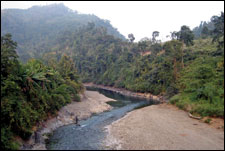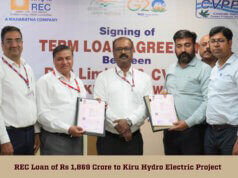 The Mizoram Power & Electricity Department has made significant progress in harnessing the PPP model to develop the Tuivai hydropower project. With the central government recently agreeing to financially assist the project through its viability gap funding mechanism, Mizoram is now moving ahead with the selection of private developers.
The Mizoram Power & Electricity Department has made significant progress in harnessing the PPP model to develop the Tuivai hydropower project. With the central government recently agreeing to financially assist the project through its viability gap funding mechanism, Mizoram is now moving ahead with the selection of private developers.
The 210-MW Tuivai hydropower project coming up on Tuivai river in Champhai district in east Mizoram will be the largest power generation asset in the northeastern state.
Speaking to Projectmonitor from capital city Aizawl, K. Guite, Chief Engineer (Civil), Mizoram P&E Department, said that the department had so far completed the RfQ (request for qualification) stage and would soon proceed to issuing RfP (request for proposal). Eight bidders participated in the bidding out of which seven qualified, Guite mentioned. Some of the qualifying aspirants include Madhucon Projects; a joint venture between Soma Enterprises and Turkey-based Limak; Hindustan Construction Company; GVK Group; and a consortium headed by Patel Engineers.
The Tuivai project, according to information available with Projectmonitor, could also be the first instance of PPP with VGF mode being deployed in any hydropower project in the country. Discussing the modalities, Guite explained that the developer would be selected on the basis of least VGF. In other words, the winning developer would be one that seeks the lowest amount of assistance under the VGF mechanism.
It must be appreciated that all PPP in the power sector is based on the competitive tariff-based mechanism, effective January 2011. However, for hydropower projects, the old “cost-plus” regime will continue till the end of 2015. Industry sources also indicate that the tariff-based modality might not be extended to hydropower projects even after 2015 as hydropower projects, unlike thermal ones, have inherent difficulties and uncertainties during the construction phase. This adversely affects the return on investment for the developer.
The Tuivai project will have a concession period of 35 years, including a construction period of around five years. The project will be developed through a special purpose vehicle owned by the selected developer and with the Mizoram government having a very small equity share. The project will involve construction of a storage dam and will have three units of 70 MW each. Guite expected that construction work on the project should start within a year from now.
The 210-MW hydropower asset would mean much to Mizoram that is now struggling to meet its power requirements. The state-owned power department has hydropower capacity of only around 29 MW, which is a far cry from the estimated demand of 107 MW. There is also a 23-MW thermal power plant at Bairabi that runs on heavy fuel oil. However, as its generation cost is very high, in the region of `8 per kwh, it is not in operation. Mizoram almost entirely depends on grid power. Despite augmenting its own generation with a 65-MW feed from the grid, the state’s electricity demands are not fully met.
Apart from the Tuivai project, Mizoram’s power availability will shore up once the Tuirial hydropower project of North Eastern Electric Power Corporation is commissioned. The 60-MW project in Aizawl district, approved way back in 1998, is besieged with construction work-related delays. It is likely to be commissioned only by 2017, by current thinking.
Mizoram is also grappling with high aggregate technical & commercial (ATC) losses in the power sector that currently stand at 28 per cent. To this effect, the state is implementing various initiatives envisaged in the Restructured Accelerated Power Development & Reforms Programme (R-APDRP). Besides, works under the centrally-sponsored Rajiv Gandhi Grameen Vidyutikaran Yojana are also ensuring that power reaches remote villages.
As of today, Mizoram’s huge hydropower potential, estimated at some 4,500 MW, has been tapped to the extent of less than 1 per cent. If the Tuivai hydropower project sees light of day, and that too without too much encumbrance, Mizoram might succeed in enticing further private enterprise for hydropower development. Currently, much of Mizoram’s spending in the power sector is towards “direction and administration,” which includes payment of salaries of power department officials and taking care of general administration. There are very little funds left for creation and upkeep of power-related infrastructure.
Northeastern India, led by Arunachal Pradesh, has abundant hydropower potential that lies untapped. Several projects have been awarded to the private sector over the past decade but the wait for the first private sector hydropower project in northeast India continues.












[…] Task Force on Hydro power development may take up the issue of the extension of provision of cost plus tariff regime for […]